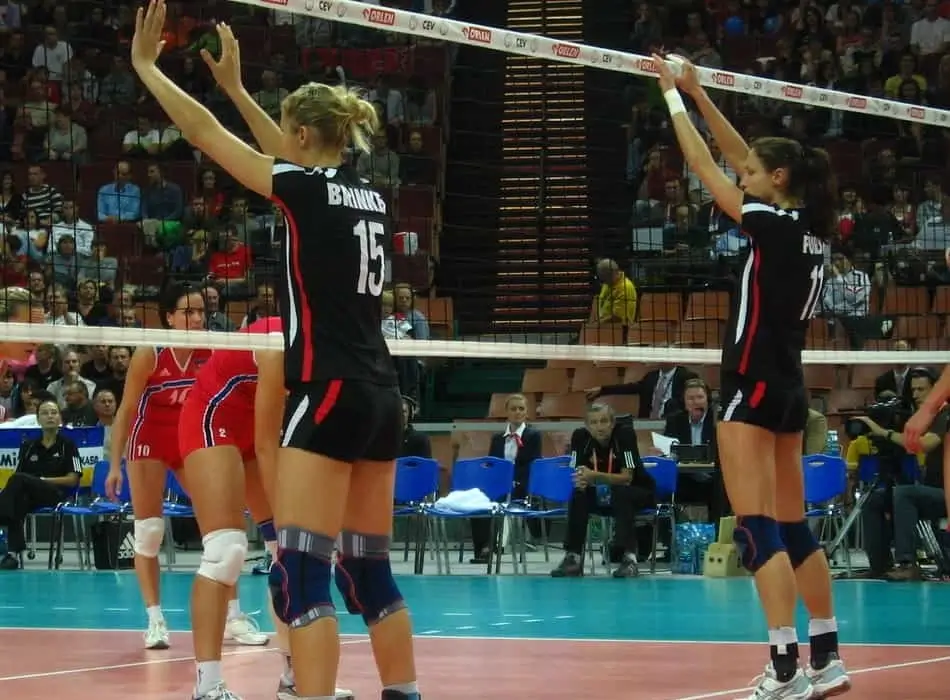Last Updated: February 28, 2024
Unlike other sports, volleyball is often considered as a defensive team sport. For instance, a good attack often defines the winner in any other sport. Basically, you need to score more than the other team. While the same concept applies in volleyball, a common cliché claims that defense wins championships.
Defense is so useful in volleyball because a single dig is more than enough to put your team in an offensive position. Being able to dig and block is, therefore, an essential part of your defensive strategy.

Here are a few other ideas to make sure your team can make the difference.
Main Pillars for Defense in Volleyball
1. Positioning is Critical
Without proper positioning, defense becomes completely useless. Positioning isn’t all about being in the right place on the court, though. Are you a backcourt defender? Make sure you’re on the balls of your feet. Your body should be facing forward, with your butt slightly down. A low body position is a must.
With this position, your arms will be just under the ball but above the floor. You must anticipate the direction of the ball, meet it and avoid going down with it.
Your position is between the ball flight and the half court. You must be able to block or dig it, no other option. Your defense must transition into an attack, then.
Having the right position will increase the chance of a proper dig or block. As a defender, you must be in this position before the attacker hits. When the hit comes, you should be ready to jump in the right direction. If you’re not in it, it’s too late, and you’re very likely to miss the attack.
2. Moving Flexibility Explained
As a defender, you must always follow the ball with your eyes. Most defenders will end up asking themselves if they’re in the right position every now and then. The idea is simple. If you can get, block or dig the ball, you are.
In terms of positioning, you need to know that it’s much easier to rush towards the inside of the court than towards the outside. It’s also a more efficient move, so you can dig it a lot easier.
The so-called theory of centrality won’t work if everyone crowds up in the middle. Instead, all defenders should focus on the lines. Wing players must be close to the sidelines, while deep players should base their positions around the endline.
Players digging by the back shouldn’t cross moves. Instead, there should be parallel movements. This means you may have to move against your instinct at times. Other than that, it’s important to avoid falling, unless you really need to. And if you do, make sure it’s after you make contact with the ball.
3. The Right Mindset Determination
Many times, a slight change in your mindset can change everything. Many new defenders are too focused on their positions or what they need to do when they move. They’re too focused on the actual theory, rather than the practical part.
Fortunately, there are ways to not fall in that direction. With time, you’ll gain more experience, and you’ll stop thinking about all these. But before getting there, you need to adjust your mindset a little. It sounds like a small thing, but it can change everything.
You’re a defender, so your role is to make sure no ball will ever touch the ground on your side, simple as that. Whether it’s a pass or an attack, the ball can’t hit the floor. This means you’ll need to pursue the ball in a relentless manner.
You must be aggressive in defense, but still retain control. It doesn’t mean you can step over other players’ toes or areas, as an organized type of aggression can actually cause more problems.
4. Set a Goal
Talking about mindsets, you’ll also have to set some goals around the fundamental principles of defense. You need to prevent the ball from hitting the floor in your court. Now, if you think about it, that’s a pretty large area to cover. Your defensive zone covers around 600 square feet.
It’s nearly impossible to cover the whole area, especially when it comes to individual goals. At this point, there are two things to consider.
Recommended: 10 Tips to Up Your Volleyball Defensive Game
What are you trying to defend? You’ll have to focus on a certain area of the court, based on your capabilities.
What are you ready to give up? If you focus on one thing, you’ll overlook another.
This way, having goals will help you be more organized. You’ll know what you want to defend and what you’re giving up. These things might match perfectly with another defender’s goals. Once you have the goals right, try to observe your mates’ goals as well.
5. How to Analyze your Competition
Analyzing opponent attackers isn’t all about their hitting styles, strengths and weaknesses. Your team’s capabilities should also be considered based on your original analysis. How good is your team when it comes to backcourt defense? What about the opponent block? Strengths? Weaknesses?
Where do most attacks come from, and what side of your court is exposed? Once you complete this initial assessment of your opponent, you need to turn around and look at your team.
The defense must be organized by the strength of your colleagues before anything else. Then, you’ll have to focus on areas that opponents are likely to attack.
Finally, consider the weaknesses of your colleagues as well. Based on your initial analysis, you can probably hide a weaker blocker here and there, not to mention disguising a weak backcourt defender into a different position.
Some of these tactics and ideas are among a coach’s responsibilities, but you need adjustments yourself as a player, too.
Final Note
There are countless ideas and strategies to implement into your defensive goals and techniques. Some of them are more important than others.
The above mentioned ideas are the main pillars of your defensive strategy, which can be adjusted later on based on the overall team goals or the opponents’ strategies.
